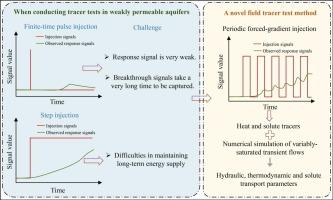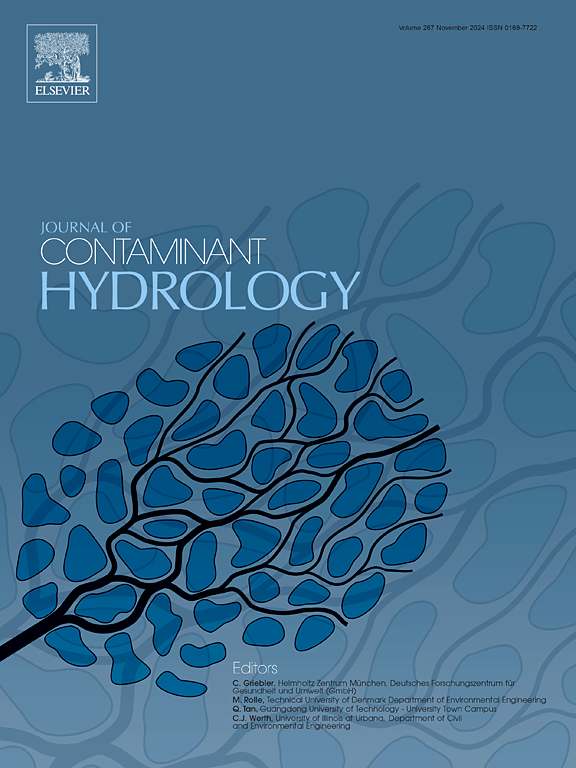Periodic forced-gradient heat and solute tracer tests to characterize the hydraulic, thermodynamic and transport properties of unconfined weakly permeable aquifers
IF 4.4
3区 环境科学与生态学
Q2 ENVIRONMENTAL SCIENCES
引用次数: 0
Abstract
Shallow unconfined weakly permeable aquifers (UWPAs) often serve as contaminant accumulation zones. Understanding the hydraulic (e.g., hydraulic conductivity), thermodynamic (e.g., thermal conductivity) and solute transport (e.g., dispersivity) parameters of UWPAs is crucial for studying contaminant transport and contamination control. Simultaneous in-situ acquisition of these multi-physical properties is often achieved through heat and solute tracer tests. However, due to the poor permeability of UWPAs, the traditional finite-time pulse injection method generates weak signals that decay rapidly. This was demonstrated by the failure to observe a breakthrough signal in the preliminary single-pulse test attempts. Step injection requires a continuous constant amount of injected signal, demanding large amounts of energy and reliable operation of the heating system. These limitations make it challenging to conduct pulse and step injection tracer experiments at a field scale to capture breakthrough signals. To address this problem, this study proposed periodic forced-gradient heat and solute tracer tests (PFHST). Unlike single pulse and step injections, PFHST established cumulative effects through repeated pulse stimulation, thus resolving both the weak signal issue of single pulse tests and the continuous energy supply challenges of step tests. Field experiments coupled with numerical modeling confirmed the feasibility of PFHST for estimating the multi-physical parameters of UWPAs. Additionally, the stability and diffusion behavior of heat and solute tracers were systematically evaluated under the given conditions, revealing that the heat tracer was more reliable than the solute tracer within UWPAs. Furthermore, key factors affecting groundwater flow, heat and solute transport in UWPA were identified through orthogonal-test sensitivity analysis, providing insights for the development of streamlined contaminant transport models. The proposed framework offers a promising way for rapid and simultaneous acquisition of multi-physical parameters of UWPAs when conventional methods cannot be carried out.

周期性强迫梯度热和溶质示踪试验,以表征无约束弱渗透含水层的水力、热力学和输运特性
浅层无侧限弱渗透含水层常作为污染物聚集带。了解uwpa的水力(例如,水力导电性)、热力学(例如,导热性)和溶质传输(例如,分散性)参数对于研究污染物传输和污染控制至关重要。通常通过热和溶质示踪测试来同时获取这些多物理性质。然而,由于uwpa的渗透率较差,传统的有限时间脉冲注入方法产生的信号较弱,衰减很快。在初步的单脉冲测试尝试中,未能观察到突破信号,证明了这一点。阶梯式注入需要连续恒定的注入信号,需要大量的能量和加热系统的可靠运行。这些限制使得在现场进行脉冲和阶跃注入示踪剂实验以捕获突破信号具有挑战性。为了解决这个问题,本研究提出了周期性强迫梯度热溶质示踪试验(PFHST)。与单脉冲和阶梯注入不同,PFHST通过重复脉冲刺激建立累积效应,从而解决了单脉冲测试的微弱信号问题和阶梯测试的持续能量供应问题。现场实验与数值模拟相结合,证实了PFHST估计超水波区多物性参数的可行性。此外,系统评价了热示踪剂和溶质示踪剂在特定条件下的稳定性和扩散行为,表明热示踪剂比溶质示踪剂在uwpa中更可靠。此外,通过正交试验敏感性分析,确定了影响UWPA地下水流动、热量和溶质运移的关键因素,为流线型污染物运移模型的发展提供了见解。在常规方法无法实现的情况下,提出的框架为快速、同时获取uwpa的多物理参数提供了一种有希望的方法。
本文章由计算机程序翻译,如有差异,请以英文原文为准。
求助全文
约1分钟内获得全文
求助全文
来源期刊

Journal of contaminant hydrology
环境科学-地球科学综合
CiteScore
6.80
自引率
2.80%
发文量
129
审稿时长
68 days
期刊介绍:
The Journal of Contaminant Hydrology is an international journal publishing scientific articles pertaining to the contamination of subsurface water resources. Emphasis is placed on investigations of the physical, chemical, and biological processes influencing the behavior and fate of organic and inorganic contaminants in the unsaturated (vadose) and saturated (groundwater) zones, as well as at groundwater-surface water interfaces. The ecological impacts of contaminants transported both from and to aquifers are of interest. Articles on contamination of surface water only, without a link to groundwater, are out of the scope. Broad latitude is allowed in identifying contaminants of interest, and include legacy and emerging pollutants, nutrients, nanoparticles, pathogenic microorganisms (e.g., bacteria, viruses, protozoa), microplastics, and various constituents associated with energy production (e.g., methane, carbon dioxide, hydrogen sulfide).
The journal''s scope embraces a wide range of topics including: experimental investigations of contaminant sorption, diffusion, transformation, volatilization and transport in the surface and subsurface; characterization of soil and aquifer properties only as they influence contaminant behavior; development and testing of mathematical models of contaminant behaviour; innovative techniques for restoration of contaminated sites; development of new tools or techniques for monitoring the extent of soil and groundwater contamination; transformation of contaminants in the hyporheic zone; effects of contaminants traversing the hyporheic zone on surface water and groundwater ecosystems; subsurface carbon sequestration and/or turnover; and migration of fluids associated with energy production into groundwater.
 求助内容:
求助内容: 应助结果提醒方式:
应助结果提醒方式:


